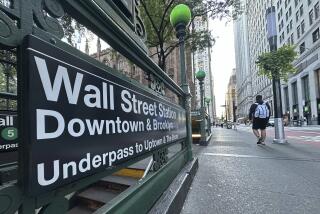Latin Economies Hit Skids Again
- Share via
Pessimism in the world financial community over whether Latin America’s sickly economies can claw their way out of recession any time soon has sent the region’s stock markets reeling and interest rates soaring in recent weeks.
A regionwide recovery was expected by late this year, but political worries and the prospect of a U.S. slowdown have economists now forecasting that Latin America may take longer to rebound. After gaining 30% from January to May, Latin American stocks are down 18% since May, according to the International Finance Corp. index of Latin stocks.
Much of those losses have occurred in the last two weeks. Mexican and Brazilian stock indexes, the region’s biggest, are down 13% and 11%, respectively, since July 23. And interest rates have shot up in Mexico and Argentina.
An end to the downtrends as soon as possible is important to the U.S., because thousands of U.S. workers’ jobs depend on exports to the region, Last year, 20% of all U.S. exports were sold south of the border.
In economic terms, this year was already pegged as a loser for Latin America, due to the lingering effects of the Asian economic crisis, last year’s Russian debt default and temblors from Brazil’s currency devaluation in January. No fewer than five of South America’s major countries are currently mired in recession.
As a whole, the region’s economic output is forecast to shrink by between 0.4% and 1% in 1999, the first contraction in a decade, the United Nations’ Economic Commission for Latin America and the Caribbean said this week. As recently as 1997, the region’s economy grew by 5%.
“I don’t expect things to improve much until next year. None of these problems are ones that can be fixed quickly,” said Lacey Gallagher, director of Latin America debt ratings at Standard & Poor’s.
The change of outlook is being driven by internal and external concerns. Political turmoil in several countries, including Venezuela, Colombia and Argentina, appear to be jeopardizing the free-market reforms that in recent years have led to increased foreign investment and expanded markets.
Also feeding the pessimism are concerns about a possible slowing of the U.S. economy and further interest rate hikes. Higher rates would hurt the several Latin countries that are knee-deep in debt, and a U.S. slowdown would dampen the market for already hard-hit Latin American exports, said Lawrence Goodman, managing director of Global Economic Associates advisory firm in New York.
Hopes for a recovery were fueled by rebounding commodities prices earlier this year, particularly oil and other minerals. Also, Brazil’s situation stabilized this spring after the appointment of former George Soros associate Arminio Fraga as head of the central bank reassured financial markets.
Brazil’s economy, the largest on the continent, may now contract only 1%, not 4% as was feared in the aftermath of January’s devaluation. Another bright light: Peru, whose economy is expected to grow 3% this year on the basis of improved mining and fishing activity.
But the good news seems outweighed by the bad.
In Argentina, the nation is wrestling with $150 billion in foreign debt, obligations that would become only more costly to pay if U.S. interest rates rise. There have also been isolated calls that the nation abandon its currency’s peg to the dollar, a link that has been credited with stabilizing Argentina’s economy.
An Argentine presidential candidate Eduardo Duhalde caused an international furor last month by suggesting a debt payment moratorium, later retracting the idea. The markets were already nervous about the upcoming departure of President Carlos Menem, a staunch free-market reformer, said Sebastian Edwards, international business professor at UCLA and former World Bank economist.
“Meanwhile, in Chile, we may see the first socialist president [if candidate Ricardo Lagos wins this year’s election] since Salvador Allende,” Edwards said, adding that such an event could reverse Chile’s two-decade trend of economic liberalization.
Even Mexico, which may grow by 3% this year, is being viewed more guardedly. Fernando Losada, senior Latin American economist at ING Barings in New York, said he is alarmed by Mexico’s strong peso and weaker U.S. economic growth. Mexico’s recovery since its 1994 peso devaluation has been closely tied to the strong U.S. economy.
Guerrilla warfare in Colombia and lack of legislative consensus in Ecuador are pushing those countries into chaos unforeseen by the experts. And populist Venezuelan President Hugo Chavez this week convened a new constitutional assembly in a bid to shift more power to the executive branch, a move that has the financial community on pins and needles.
“People are really unclear about how the politics are going to evolve in Venezuela and this had led to a lot of caution in terms of investment,” said Jeffrey Schott, senior fellow at the Institute for International Economics in Washington. “You could have everything from anarchy to an authoritarian regime evolve out of this.”
Also in question is the slate of fiscal reforms that Brazilian President Fernando Henrique Cardoso will put before his congress next week.
Cardoso’s base of support has weakened significantly in recent months, which could augur poorly for his program.
Edmar Bacha, president of BBA Securities in New York, said passage of the reforms is crucial if Brazil is to comply with terms of its $41.5-billion bailout orchestrated last year by the International Monetary Fund.
“I don’t see any positive upside surprises possible in any of these Latin American countries on the policy front,” said Siobhan Manning, a PaineWebber debt analyst.
(BEGIN TEXT OF INFOBOX / INFOGRAPHIC)
Hemisphere Headaches
Latin America’s economies were expected to recover this year, but internal and external factors are likely to keep the region mired in recession.
1. Mexico
Although it was on track to post 3% economic growth this year, the stock market’s key Bolsa index has lost 12% since July 1 on fears that higher U.S. interest rates and slower economic growth will trickle south.
2. Colombia
Besieged by rebels and a shaky banking system, the country is in danger of losing its sterling credit rating, which it has maintained through three decades of Latin crises.
3. Venezuela
The government laid off 30,000 state oil workers because production--and prices--are down, and new President Hugo Chavez is convening a constitutional assembly to increase executive powers.
4. Brazil
Although the monetary situation has stabilized since January’s devaluation, the government’s slate of fiscal reforms appears to be in jeopardy because of President Fernando Henrique Cardoso’s waning political support.
5. Chile
With the economy in the doldrums, candidate Ricardo Lagos this fall may become the first socialist to win a presidential election since Salvador Allende in 1970.
6. Argentina
Industrial production is down 13%. Markets were shaken last month when a populist presidential candidate issued and then retracted a call for a moratorium on debt payments.
How the Markets Have Fared
*--*
Country (index) 1999 peak Friday close % change from peak Venezuela (IBC) 6,531.35 4,650.08 -29% Colombia (Bolsa) 1,237.28 894.42 -28 Argentina (Merval) 607.57 464.89 -23 Brazil (Bovespa) 12,589.10 10,038.86 -20 Mexico (Bolsa) 6,192.86 5,029.22 -19 Chile (General) 4,977.17 4,734.27 -5
*--*
Sources: Bloomberg News, Times research
More to Read
Sign up for Essential California
The most important California stories and recommendations in your inbox every morning.
You may occasionally receive promotional content from the Los Angeles Times.










